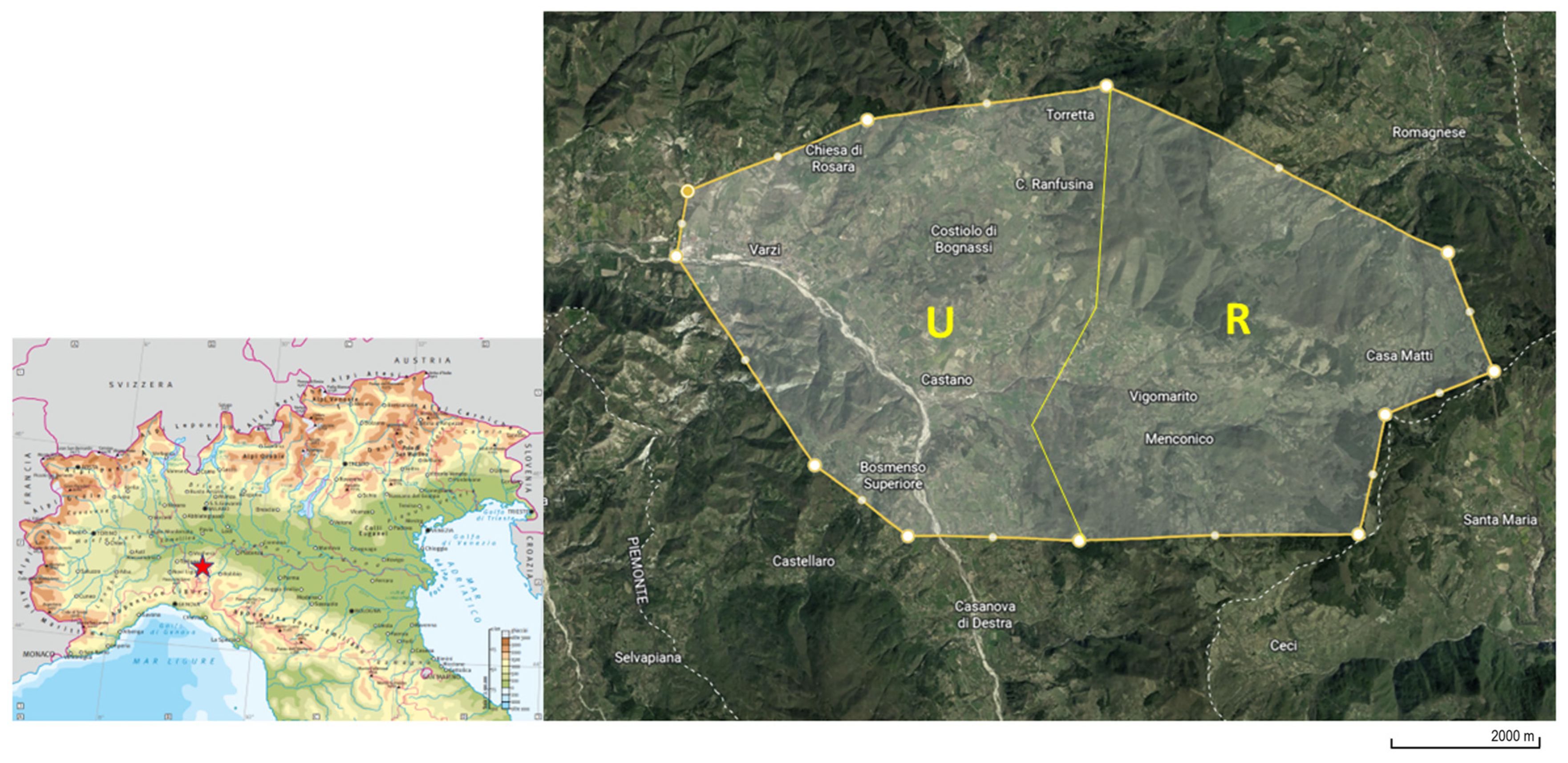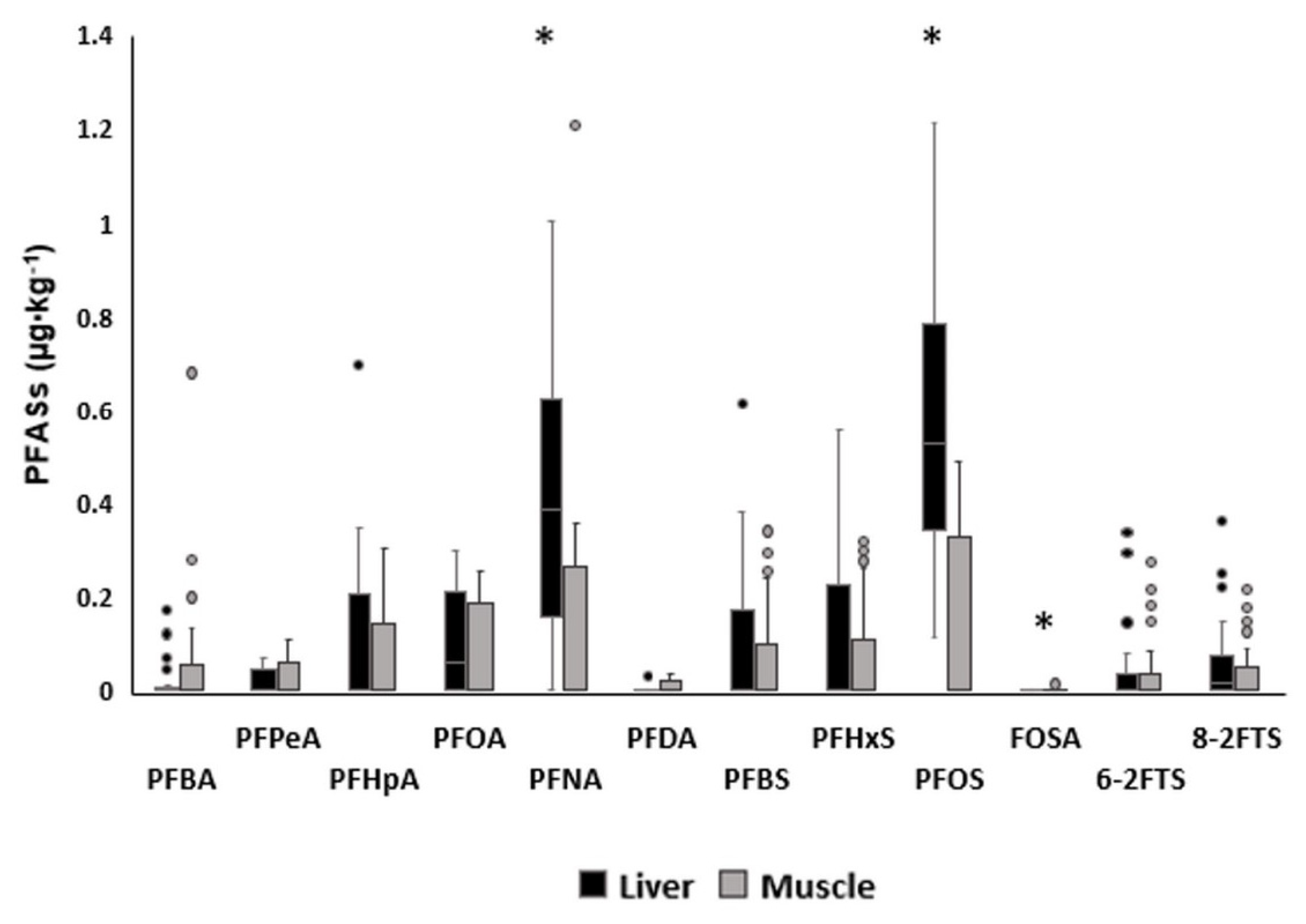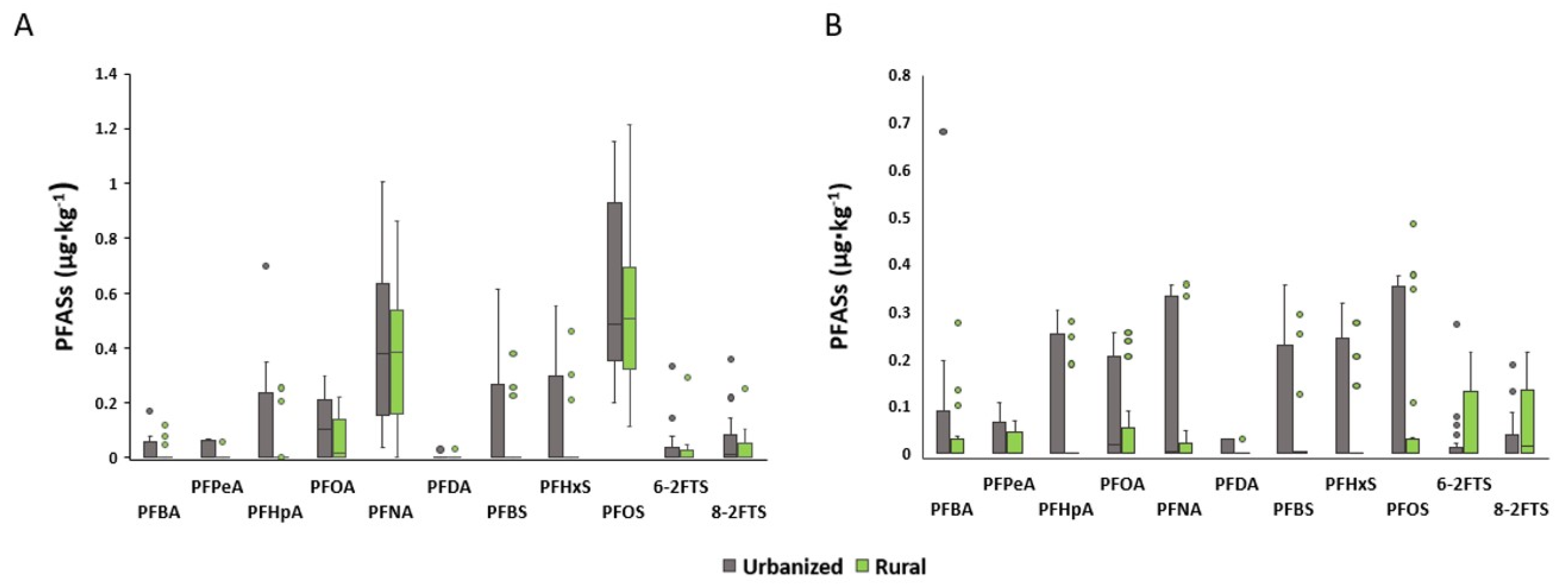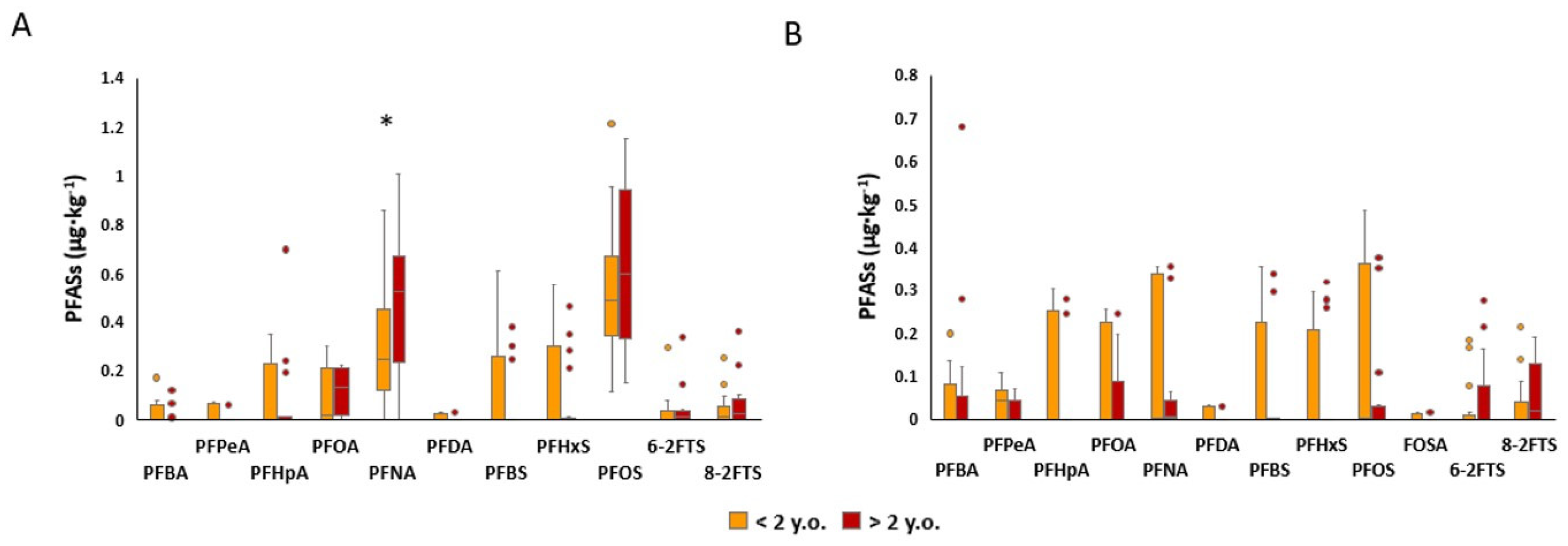Influence of Area, Age and Sex on Per- and Polyfluorinated Alkyl Substances Detected in Roe Deer Muscle and Liver from Selected Areas of Northern Italy
Abstract
Simple Summary
Abstract
1. Introduction
2. Materials and Methods
2.1. Chemicals and Reagents
2.2. Sample Collection and Preparation for the Extraction
2.3. Extraction Procedure and UPLC-HRMS
2.4. Method Validation
2.5. Statistical Analysis
3. Results
3.1. Distribution of Concentrations of the 15 Measured PFASs in Roe Deer Tissues and Concentrations in Liver and Muscle
3.2. Comparison between Urbanized and Rural Areas in Liver and Muscle Concentrations of PFASs from Roe Deer
3.3. Comparison between Sexes in Liver and Muscle Concentrations of PFASs
3.4. Comparison between Age Classes in Liver and Muscle Concentrations of PFASs in Roe Deer Aged < 2 y.o. and Aged > 2 y.o.
4. Discussion
4.1. PFAS Concentrations in Roe Deer Tissues
4.2. Comparison of PFAS Content in Roe Deer Tissues Belonging to Urbanized and Rural Areas
4.3. Liver and Muscle Concentrations of PFASs in Males and Females and Comparison between Sexes
4.4. Liver and Muscle Concentrations of PFASs in Roe Deer Aged < 2 y.o. and Aged > 2 y.o. and Comparison between Age Classes
5. Conclusions
Supplementary Materials
Author Contributions
Funding
Institutional Review Board Statement
Informed Consent Statement
Data Availability Statement
Conflicts of Interest
References
- Falk, S.; Brunn, H.; Schröter-Kermani, C.; Failing, K.; Georgii, S.; Tarricone, K.; Stahl, T. Temporal and Spatial Trends of Perfluoroalkyl Substances in Liver of Roe Deer (Capreolus capreolus). Environ. Pollut. 2012, 171, 1–8. [Google Scholar] [CrossRef]
- Jha, G.; Kankarla, V.; McLennon, E.; Pal, S.; Sihi, D.; Dari, B.; Diaz, D.; Nocco, M. Per- and Polyfluoroalkyl Substances (PFAS) in Integrated Crop-Livestock Systems: Environmental Exposure and Human Health Risks. Int. J. Environ. Res. Public. Health 2021, 18, 12550. [Google Scholar] [CrossRef] [PubMed]
- Rayne, S.; Forest, K. Perfluoroalkyl Sulfonic and Carboxylic Acids: A Critical Review of Physicochemical Properties, Levels and Patterns in Waters and Wastewaters, and Treatment Methods. J. Environ. Sci. Health A Toxic Hazard. Subst. Environ. Eng. 2009, 44, 1145–1199. [Google Scholar] [CrossRef] [PubMed]
- Hammer, J.; Endo, S. Volatility and Nonspecific van Der Waals Interaction Properties of Per- and Polyfluoroalkyl Substances (PFAS): Evaluation Using Hexadecane/Air Partition Coefficients. Environ. Sci. Technol. 2022, 56, 15737–15745. [Google Scholar] [CrossRef] [PubMed]
- Clarke, B.O.; Smith, S.R. Review of “emerging” Organic Contaminants in Biosolids and Assessment of International Research Priorities for the Agricultural Use of Biosolids. Environ. Int. 2011, 37, 226–247. [Google Scholar] [CrossRef] [PubMed]
- Al Amin, M.; Sobhani, Z.; Liu, Y.; Dharmaraja, R.; Chadalavada, S.; Naidu, R.; Chalker, J.M.; Fang, C. Recent Advances in the Analysis of Per- and Polyfluoroalkyl Substances (PFAS): A Review. Environ. Technol. Innov. 2020, 19, 100879. [Google Scholar] [CrossRef]
- Brusseau, M.L.; Anderson, R.H.; Guo, B. PFAS Concentrations in Soils: Background Levels versus Contaminated Sites. Sci. Total Environ. 2020, 740, 140017. [Google Scholar] [CrossRef]
- Parsons, J.R.; Sáez, M.; Dolfing, J.; de Voogt, P. Biodegradation of Perfluorinated Compounds. Rev. Environ. Contam. Toxicol. 2008, 196, 53–71. [Google Scholar] [CrossRef]
- Takacs, M.L.; Abbott, B.D. Activation of Mouse and Human Peroxisome Proliferator-Activated Receptors (Alpha, Beta/Delta, Gamma) by Perfluorooctanoic Acid and Perfluorooctane Sulfonate. Toxicol. Sci. 2007, 95, 108–117. [Google Scholar] [CrossRef]
- Vestergren, R.; Cousins, I.T. Tracking the Pathways of Human Exposure to Perfluorocarboxylates. Environ. Sci. Technol. 2009, 43, 5565–5575. [Google Scholar] [CrossRef]
- Christensen, K.Y.; Raymond, M.; Meiman, J. Perfluoroalkyl Substances and Metabolic Syndrome. Int. J. Hyg. Environ. Health 2019, 222, 147–153. [Google Scholar] [CrossRef] [PubMed]
- Coperchini, F.; Croce, L.; Ricci, G.; Magri, F.; Rotondi, M.; Imbriani, M.; Chiovato, L. Thyroid Disrupting Effects of Old and New Generation PFAS. Front. Endocrinol. 2021, 11, 612320. [Google Scholar] [CrossRef]
- Stanifer, J.W.; Stapleton, H.M.; Souma, T.; Wittmer, A.; Zhao, X.; Boulware, L.E. Perfluorinated Chemicals as Emerging Environmental Threats to Kidney Health: A Scoping Review. Clin. J. Am. Soc. Nephrol. 2018, 13, 1479–1492. [Google Scholar] [CrossRef] [PubMed]
- Jeddy, Z.; Tobias, J.H.; Taylor, E.V.; Northstone, K.; Flanders, W.D.; Hartman, T.J. Prenatal Concentrations of Perfluoroalkyl Substances and Bone Health in British Girls at Age 17. Arch. Osteoporos. 2018, 13, 84. [Google Scholar] [CrossRef] [PubMed]
- Ehrlich, V.; Bil, W.; Vandebriel, R.; Granum, B.; Luijten, M.; Lindeman, B.; Grandjean, P.; Kaiser, A.M.; Hauzenberger, I.; Hartmann, C.; et al. Consideration of Pathways for Immunotoxicity of Per- and Polyfluoroalkyl Substances (PFAS). Environ. Health 2023, 22, 1–47. [Google Scholar] [CrossRef] [PubMed]
- Liang, L.; Pan, Y.; Bin, L.; Liu, Y.; Huang, W.; Li, R.; Lai, K.P. Immunotoxicity Mechanisms of Perfluorinated Compounds PFOA and PFOS. Chemosphere 2022, 291, 132892. [Google Scholar] [CrossRef]
- Rendón-Lugo, A.N.; Santiago, P.; Puente-Lee, I.; León-Paniagua, L. Permeability of Hair to Cadmium, Copper and Lead in Five Species of Terrestrial Mammals and Implications in Biomonitoring. Environ. Monit. Assess. 2017, 189, 640. [Google Scholar] [CrossRef]
- Zhou, Q.; Zhang, J.; Fu, J.; Shi, J.; Jiang, G. Biomonitoring: An Appealing Tool for Assessment of Metal Pollution in the Aquatic Ecosystem. Anal. Chim. Acta 2008, 606, 135–150. [Google Scholar] [CrossRef]
- Cygan-Szczegielniak, D.; Stasiak, K. Effects of Age and Sex on the Content of Heavy Metals in the Hair, Liver and the Longissimus Lumborum Muscle of Roe Deer Capreolus capreolus L. Environ. Sci. Pollut. Res. Int. 2022, 29, 10782–10790. [Google Scholar] [CrossRef]
- Tixier, H.; Duncan, P.; Scehovic, J.; Yani, A.; Gleizes, M.; Lila, M. Food Selection by European Roe Deer (Capreolus capreolus): Effects of Plant Chemistry, and Consequences for the Nutritional Value of Their Diets. J. Zool. 1997, 242, 229–245. [Google Scholar] [CrossRef]
- Lehel, J.; Laczay, P.; Gyurcsó, A.; Jánoska, F.; Majoros, S.; Lányi, K.; Marosán, M. Toxic Heavy Metals in the Muscle of Roe Deer (Capreolus Capreolus)--Food Toxicological Significance. Environ. Sci. Pollut. Res. Int. 2016, 23, 4465–4472. [Google Scholar] [CrossRef] [PubMed]
- Pavlovic, R.; Draghi, S.; Pellegrini, A.; Silva, C.F.; Di Cesare, F.; Curone, G.; Arioli, F.; Fidani, M. High-Resolution Mass Spectrometry Non-Targeted Detection of Per- and Polyfluoroalkyl Substances in Roe Deer (Capreolus capreolus). Molecules 2024, 29, 617. [Google Scholar] [CrossRef]
- Varela-Castro, L.; Sevilla, I.A.; Payne, A.; Gilot-Fromont, E.; Barral, M. Interaction Patterns between Wildlife and Cattle Reveal Opportunities for Mycobacteria Transmission in Farms from North-Eastern Atlantic Iberian Peninsula. Animals 2021, 11, 2364. [Google Scholar] [CrossRef] [PubMed]
- Draghi, S.; Agradi, S.; Riva, F.; Tarhan, D.; Bilgiç, B.; Dokuzeylül, B.; Ercan, A.M.; Or, M.E.; Brecchia, G.; Vigo, D.; et al. Roe Deer (Capreolus capreolus) Hair as a Bioindicator for the Environmental Presence of Toxic and Trace Elements. Toxics 2023, 11, 49. [Google Scholar] [CrossRef] [PubMed]
- Chiesa, L.M.; Pavlovic, R.; Arioli, F.; Nobile, M.; Di Cesare, F.; Mosconi, G.; Falletta, E.; Malandra, R.; Panseri, S. Presence of Perfluoroalkyl Substances in Mediterranean Sea and North Italian Lake Fish Addressed to Italian Consumer. Int. J. Food Sci. Technol. 2022, 57, 1303–1316. [Google Scholar] [CrossRef]
- Draghi, S.; Pavlovic, R.; Pellegrini, A.; Fidani, M.; Riva, F.; Brecchia, G.; Agradi, S.; Arioli, F.; Vigo, D.; Di Cesare, F.; et al. First Investigation of the Physiological Distribution of Legacy and Emerging Perfluoroalkyl Substances in Raw Bovine Milk According to the Component Fraction. Foods 2023, 12, 2449. [Google Scholar] [CrossRef]
- Pihlström, T.; Fernández-Alba, A.R.; Ferrer Amate, C.; Erecius Poulsen, M.; Lippold, R.; Carrasco Cabrera, L.; Pelosi, P.; Valverde, A.; Unterluggauer, H.; Mol, H.; et al. Analytical Quality Control and Method Validation Procedures for Pesticide Residues Analysis in Food and Feed. Sante 2017, 11813, 21–22. [Google Scholar]
- Blake, B.E.; Fenton, S.E. Early Life Exposure to Per- and Polyfluoroalkyl Substances (PFAS) and Latent Health Outcomes: A Review Including the Placenta as a Target Tissue and Possible Driver of Peri- and Postnatal Effects. Toxicology 2020, 443, 152565. [Google Scholar] [CrossRef]
- Pérez, F.; Nadal, M.; Navarro-Ortega, A.; Fàbrega, F.; Domingo, J.L.; Barceló, D.; Farré, M. Accumulation of Perfluoroalkyl Substances in Human Tissues. Environ. Int. 2013, 59, 354–362. [Google Scholar] [CrossRef]
- La Merrill, M.; Emond, C.; Kim, M.J.; Antignac, J.P.; Le Bizec, B.; Clément, K.; Birnbaum, L.S.; Barouki, R. Toxicological Function of Adipose Tissue: Focus on Persistent Organic Pollutants. Environ. Health Perspect. 2013, 121, 162–169. [Google Scholar] [CrossRef]
- Kelly, B.C.; Ikonomou, M.G.; Blair, J.D.; Surridge, B.; Hoover, D.; Grace, R.; Gobas, F.A.P.C. Perfluoroalkyl Contaminants in an Arctic Marine Food Web: Trophic Magnification and Wildlife Exposure. Environ. Sci. Technol. 2009, 43, 4037–4043. [Google Scholar] [CrossRef]
- Pizzurro, D.M.; Seeley, M.; Kerper, L.E.; Beck, B.D. Interspecies Differences in Perfluoroalkyl Substances (PFAS) Toxicokinetics and Application to Health-Based Criteria. Regul. Toxicol. Pharmacol. 2019, 106, 239–250. [Google Scholar] [CrossRef]
- Wang, G.; Lu, J.; Xing, Z.; Li, S.; Liu, Z.; Tong, Y. Occurrence, Distribution, and Risk Assessment of Perfluoroalkyl Acids (PFAAs) in Muscle and Liver of Cattle in Xinjiang, China. Int. J. Environ. Res. Public. Health 2017, 14, 970. [Google Scholar] [CrossRef]
- Numata, J.; Kowalczyk, J.; Adolphs, J.; Ehlers, S.; Schafft, H.; Fuerst, P.; Müller-Graf, C.; Lahrssen-Wiederholt, M.; Greiner, M. Toxicokinetics of Seven Perfluoroalkyl Sulfonic and Carboxylic Acids in Pigs Fed a Contaminated Diet. J. Agric. Food Chem. 2014, 62, 6861–6870. [Google Scholar] [CrossRef]
- Lau, C. Perfluorinated Compounds: An Overview. In Molecular and Integrative Toxicology; Humana Press: Cham, Switzerland, 2015; pp. 1–21. [Google Scholar] [CrossRef]
- Knutsen, H.K.; Alexander, J.; Barregård, L.; Bignami, M.; Brüschweiler, B.; Ceccatelli, S.; Cottrill, B.; Dinovi, M.; Edler, L.; Grasl-Kraupp, B.; et al. Risk to Human Health Related to the Presence of Perfluorooctane Sulfonic Acid and Perfluorooctanoic Acid in Food. EFSA J. 2018, 16, e05194. [Google Scholar] [CrossRef]
- Sharp, S.; Sardiña, P.; Metzeling, L.; McKenzie, R.; Leahy, P.; Menkhorst, P.; Hinwood, A. Per- and Polyfluoroalkyl Substances in Ducks and the Relationship with Concentrations in Water, Sediment, and Soil. Environ. Toxicol. Chem. 2021, 40, 846–858. [Google Scholar] [CrossRef]
- Chen, W.L.; Bai, F.Y.; Chang, Y.C.; Chen, P.C.; Chen, C.Y. Concentrations of Perfluoroalkyl Substances in Foods and the Dietary Exposure among Taiwan General Population and Pregnant Women. J. Food Drug Anal. 2018, 26, 994–1004. [Google Scholar] [CrossRef] [PubMed]
- Death, C.; Bell, C.; Champness, D.; Milne, C.; Reichman, S.; Hagen, T. Per- and Polyfluoroalkyl Substances (PFAS) in Livestock and Game Species: A Review. Sci. Total Environ. 2021, 774, 144795. [Google Scholar] [CrossRef] [PubMed]
- Cygan-Szczegielniak, D.; Stanek, M.; Stasiak, K.; Roślewska, A.; Janicki, B. The Content of Mineral Elements and Heavy Metals in the Hair of Red Deer (Cervus elaphus L.) from Selected Regions of Poland. Folia Biol. 2018, 66, 133–142. [Google Scholar] [CrossRef]
- Sunderland, E.M.; Hu, X.C.; Dassuncao, C.; Tokranov, A.K.; Wagner, C.C.; Allen, J.G. A Review of the Pathways of Human Exposure to Poly- and Perfluoroalkyl Substances (PFASs) and Present Understanding of Health Effects. J. Expo. Sci. Environ. Epidemiol. 2019, 29, 131–147. [Google Scholar] [CrossRef] [PubMed]
- Aluc, Y.; Ekici, H. Investigation of Heavy Metal Levels in Blood Samples of Three Cattle Breeds in Turkey. Bull. Environ. Contam. Toxicol. 2019, 103, 739–744. [Google Scholar] [CrossRef] [PubMed]
- Karastergiou, K.; Smith, S.R.; Greenberg, A.S.; Fried, S.K. Sex Differences in Human Adipose Tissues—The Biology of Pear Shape. Biol. Sex. Differ. 2012, 3, 13. [Google Scholar] [CrossRef] [PubMed]
- Jandacek, R.J.; Tso, P. Factors Affecting the Storage and Excretion of Toxic Lipophilic Xenobiotics. Lipids 2001, 36, 1289–1305. [Google Scholar] [CrossRef] [PubMed]
- Kohalmy, K.; Vrzal, R. Regulation of Phase II Biotransformation Enzymes by Steroid Hormones. Curr. Drug Metab. 2011, 12, 104–123. [Google Scholar] [CrossRef] [PubMed]
- Ding, N.; Harlow, S.D.; Randolph, J.F.; Loch-Caruso, R.; Park, S.K. Perfluoroalkyl and Polyfluoroalkyl Substances (PFAS) and Their Effects on the Ovary. Hum. Reprod. Update 2020, 26, 724–752. [Google Scholar] [CrossRef] [PubMed]
- Fan, W.Q.; Yanase, T.; Morinaga, H.; Mu, Y.M.; Nomura, M.; Okabe, T.; Goto, K.; Harada, N.; Nawata, H. Activation of Peroxisome Proliferator-Activated Receptor-Gamma and Retinoid X Receptor Inhibits Aromatase Transcription via Nuclear Factor-KappaB. Endocrinology 2005, 146, 85–92. [Google Scholar] [CrossRef]
- Cruz-Topete, D.; Dominic, P.; Stokes, K.Y. Uncovering Sex-Specific Mechanisms of Action of Testosterone and Redox Balance. Redox Biol. 2020, 31, 101490. [Google Scholar] [CrossRef]
- Glynn, A.; Larsdotter, M.; Aune, M.; Darnerud, P.O.; Bjerselius, R.; Bergman, Å. Changes in Serum Concentrations of Polychlorinated Biphenyls (PCBs), Hydroxylated PCB Metabolites and Pentachlorophenol during Pregnancy. Chemosphere 2011, 83, 144–151. [Google Scholar] [CrossRef]
- Stawarz, R.; Formicki, G.; Massányi, P. Daily Fluctuations and Distribution of Xenobiotics, Nutritional and Biogenic Elements in Human Milk in Southern Poland. J. Environ. Sci. Health A Toxic Hazard. Subst. Environ. Eng. 2007, 42, 1169–1175. [Google Scholar] [CrossRef] [PubMed]
- Mondal, D.; Weldon, R.H.; Armstrong, B.G.; Gibson, L.J.; Lopez-Espinosa, M.J.; Shin, H.M.; Fletcher, T. Breastfeeding: A Potential Excretion Route for Mothers and Implications for Infant Exposure to Perfluoroalkyl Acids. Environ. Health Perspect. 2014, 122, 187–192. [Google Scholar] [CrossRef] [PubMed]
- Hewison, A.J.M.; Vincent, J.P.; Angibault, J.M.; Delorme, D.; Van Laere, G.; Gaillard, J.M. Tests of Estimation of Age from Tooth Wear on Roe Deer of Known Age: Variation within and among Populations. Can. J. Zool. 1999, 77, 58–67. [Google Scholar] [CrossRef]
- Tomé, C.; Vigne, J.; Tome, C.; Vigne, J. Roe Deer (Capreolus Capreolus) Age at Death Estimates: New Methods and Modern Reference Data for Tooth Eruption and Wear, and for Epiphyseal Fusion. Archaeofauna Int. J. Archaeozoology 2003, 12, 157–173. [Google Scholar]
- Shi, S.; Klotz, U. Age-Related Changes in Pharmacokinetics. Curr. Drug Metab. 2011, 12, 601–610. [Google Scholar] [CrossRef]
- Vyskočilová, E.; Szotáková, B.; Skálová, L.; Bártíková, H.; Hlaváčová, J.; Boušová, I. Age-Related Changes in Hepatic Activity and Expression of Detoxification Enzymes in Male Rats. Biomed. Res. Int. 2013, 2013, 408573. [Google Scholar] [CrossRef]
- Corton, J.C.; Lee, J.S.; Liu, J.; Ren, H.; Vallanat, B.; DeVito, M. Determinants of Gene Expression in the Human Liver: Impact of Aging and Sex on Xenobiotic Metabolism. Exp. Gerontol. 2022, 169, 111976. [Google Scholar] [CrossRef] [PubMed]
- Hunt, N.J.; Kang, S.W. (Sophie); Lockwood, G.P.; Le Couteur, D.G.; Cogger, V.C. Hallmarks of Aging in the Liver. Comput. Struct. Biotechnol. J. 2019, 17, 1151–1161. [Google Scholar] [CrossRef] [PubMed]
- Yun, K.U.; Oh, S.J.; Oh, J.M.; Kang, K.W.; Myung, C.S.; Song, G.Y.; Kim, B.H.; Kim, S.K. Age-Related Changes in Hepatic Expression and Activity of Cytochrome P450 in Male Rats. Arch. Toxicol. 2010, 84, 939–946. [Google Scholar] [CrossRef] [PubMed]
- Riyazuddin, R.; Nisha, N.; Ejaz, B.; Khan, M.I.R.; Kumar, M.; Ramteke, P.W.; Gupta, R. A Comprehensive Review on the Heavy Metal Toxicity and Sequestration in Plants. Biomolecules 2021, 12, 43. [Google Scholar] [CrossRef] [PubMed]
- Lee, E.Y.; Liszewski, M.C.; Gee, M.S.; Daltro, P.; Restrepo, R. Pediatric Body MRI: A Comprehensive, Multidisciplinary Guide; Springer: Berlin/Heidelberg, Germany, 2020; 497p. [Google Scholar]





| Compound | No. of Samples | LOD | LOQ | % Samples > LOQ | |
|---|---|---|---|---|---|
| PFBA | Perfluorobutanoic acid | 80 | 0.0006 | 0.0019 | 32.5 |
| PFPeA | Perfluoropentanoic acid | 80 | 0.0004 | 0.0012 | 33.75 |
| PFHxA | Perfluorohexanoic acid | 80 | 0.0027 | 0.0082 | N.D. |
| PFHpA | Perfluoroheptanoic acid | 80 | 0.0002 | 0.0007 | 30.0 |
| PFOA | Perfluorooctanoic acid | 80 | 0.0005 | 0.0014 | 55.0 |
| PFNA | Perfluorononanoic acid | 80 | 0.0017 | 0.0051 | 72.5 |
| PFDA | Perfluorodecanoic acid | 80 | 0.0002 | 0.0006 | 22.5 |
| FOUEA | 2H-perfluoro-2-decenoic acid | 80 | 0.0009 | 0.0027 | N.D. |
| NADONA | Sodium dodecafluoro-3H-4,8--dioxanonanoate | 80 | 0.0002 | 0.0005 | N.D. |
| PFBS | Perfluorobutanesulfonic acid | 80 | 0.0069 | 0.0210 | 26.25 |
| PFHxS | Perfluorohexanesulfonic acid | 80 | 0.0002 | 0.0007 | 27.5 |
| PFOS | Perfluorooctanesulfonic acid | 80 | 0.0005 | 0.0014 | 73.75 |
| FOSA | Perfluorooctanesulfonamide | 80 | 0.0021 | 0.0064 | 11.25 |
| 6-2FTS | 6:2-fluorotelomersulfonic acid | 80 | 0.0004 | 0.0012 | 43.75 |
| 8-2FTS | 8:2-fluorotelomersulfonic acid | 80 | 0.0004 | 0.0013 | 50 |
Disclaimer/Publisher’s Note: The statements, opinions and data contained in all publications are solely those of the individual author(s) and contributor(s) and not of MDPI and/or the editor(s). MDPI and/or the editor(s) disclaim responsibility for any injury to people or property resulting from any ideas, methods, instructions or products referred to in the content. |
© 2024 by the authors. Licensee MDPI, Basel, Switzerland. This article is an open access article distributed under the terms and conditions of the Creative Commons Attribution (CC BY) license (https://creativecommons.org/licenses/by/4.0/).
Share and Cite
Draghi, S.; Curone, G.; Pavlovic, R.; Di Cesare, F.; Cagnardi, P.; Fornesi Silva, C.; Pellegrini, A.; Riva, F.; Arioli, F.; Fidani, M. Influence of Area, Age and Sex on Per- and Polyfluorinated Alkyl Substances Detected in Roe Deer Muscle and Liver from Selected Areas of Northern Italy. Animals 2024, 14, 529. https://doi.org/10.3390/ani14040529
Draghi S, Curone G, Pavlovic R, Di Cesare F, Cagnardi P, Fornesi Silva C, Pellegrini A, Riva F, Arioli F, Fidani M. Influence of Area, Age and Sex on Per- and Polyfluorinated Alkyl Substances Detected in Roe Deer Muscle and Liver from Selected Areas of Northern Italy. Animals. 2024; 14(4):529. https://doi.org/10.3390/ani14040529
Chicago/Turabian StyleDraghi, Susanna, Giulio Curone, Radmila Pavlovic, Federica Di Cesare, Petra Cagnardi, Claudia Fornesi Silva, Alberto Pellegrini, Federica Riva, Francesco Arioli, and Marco Fidani. 2024. "Influence of Area, Age and Sex on Per- and Polyfluorinated Alkyl Substances Detected in Roe Deer Muscle and Liver from Selected Areas of Northern Italy" Animals 14, no. 4: 529. https://doi.org/10.3390/ani14040529
APA StyleDraghi, S., Curone, G., Pavlovic, R., Di Cesare, F., Cagnardi, P., Fornesi Silva, C., Pellegrini, A., Riva, F., Arioli, F., & Fidani, M. (2024). Influence of Area, Age and Sex on Per- and Polyfluorinated Alkyl Substances Detected in Roe Deer Muscle and Liver from Selected Areas of Northern Italy. Animals, 14(4), 529. https://doi.org/10.3390/ani14040529









